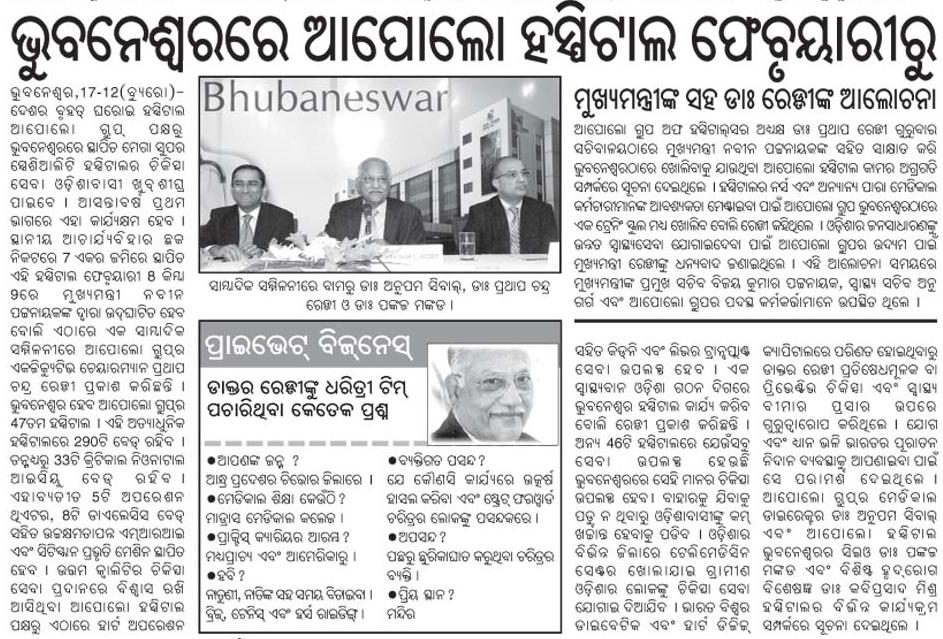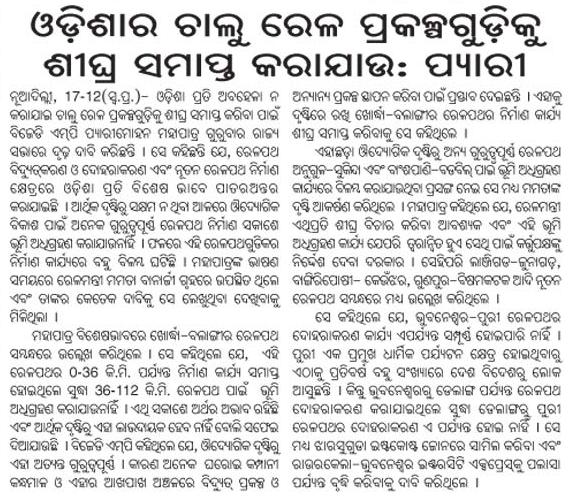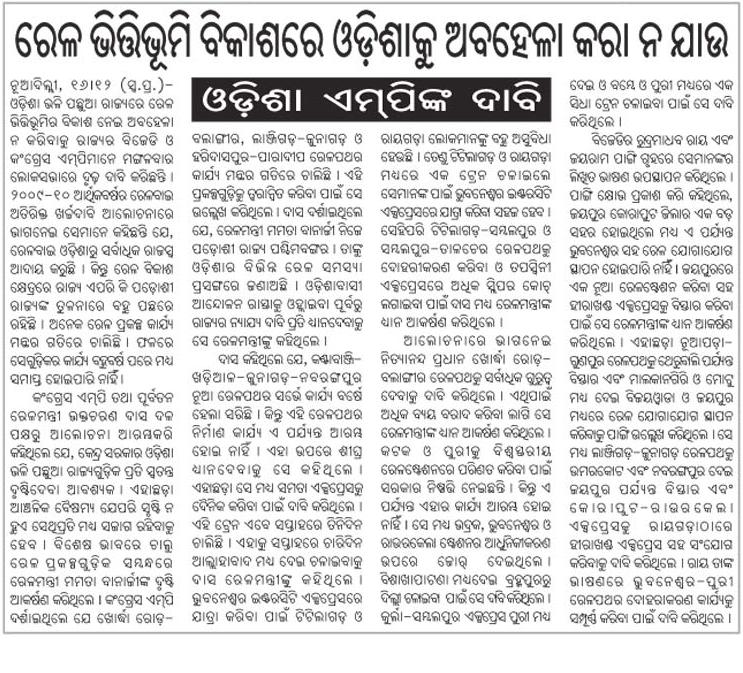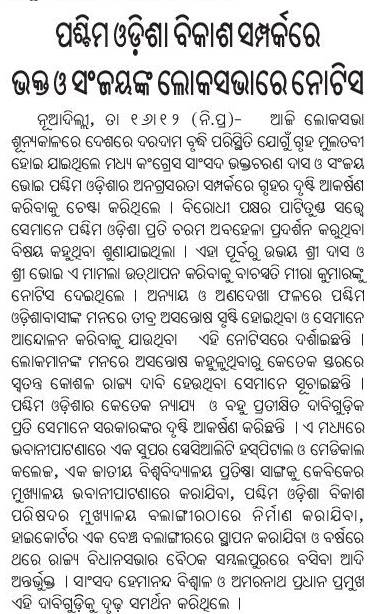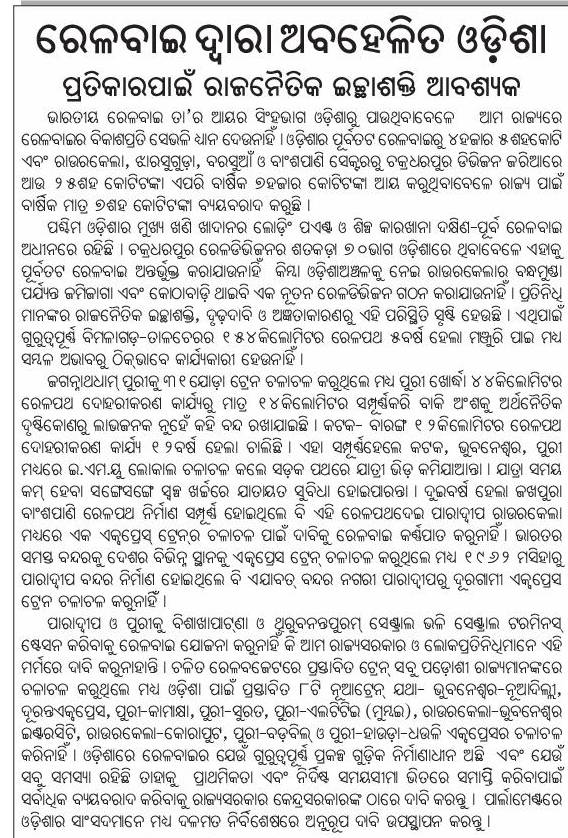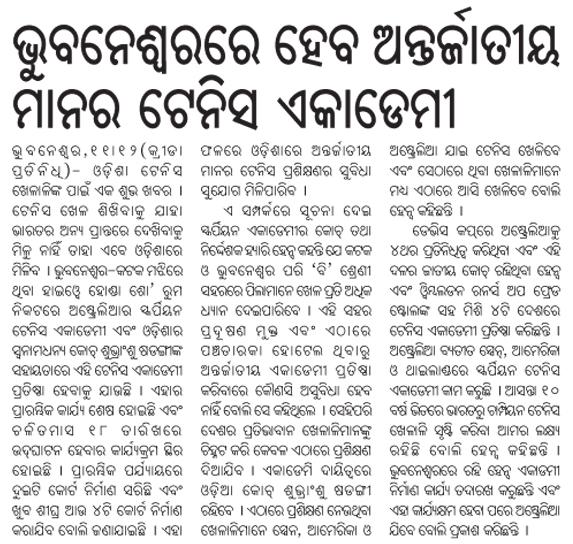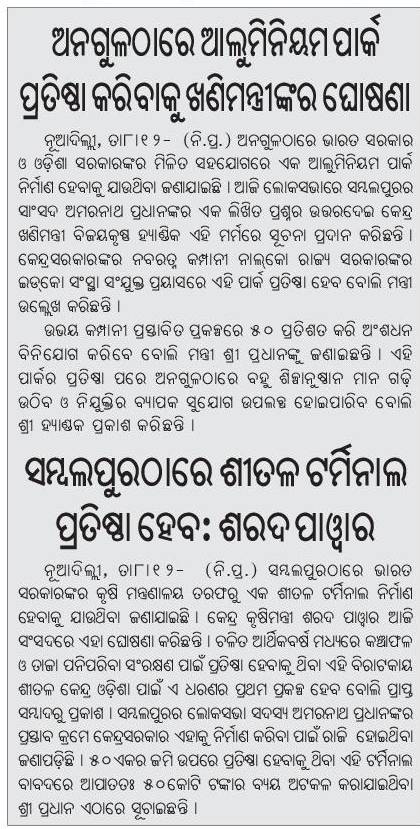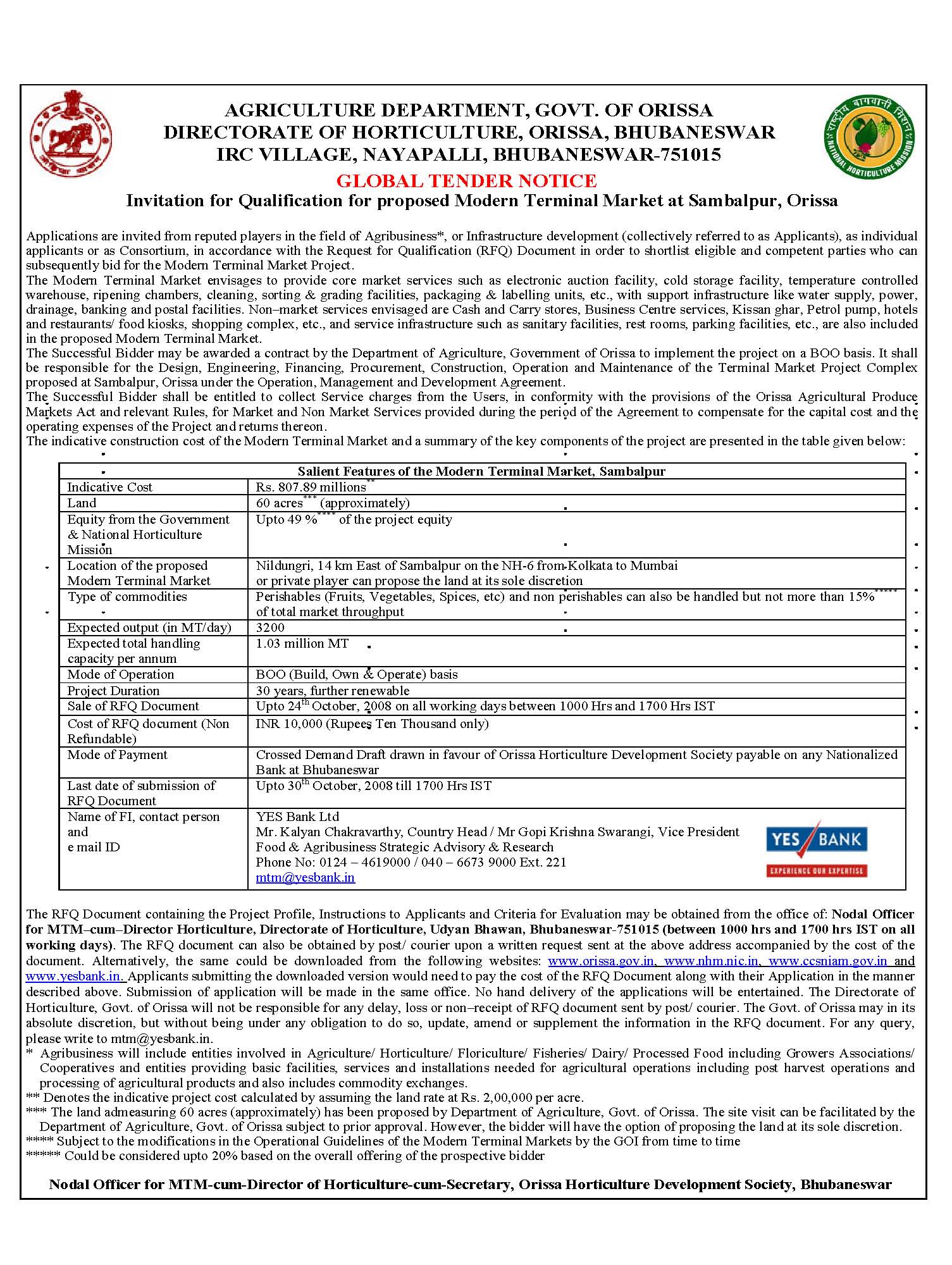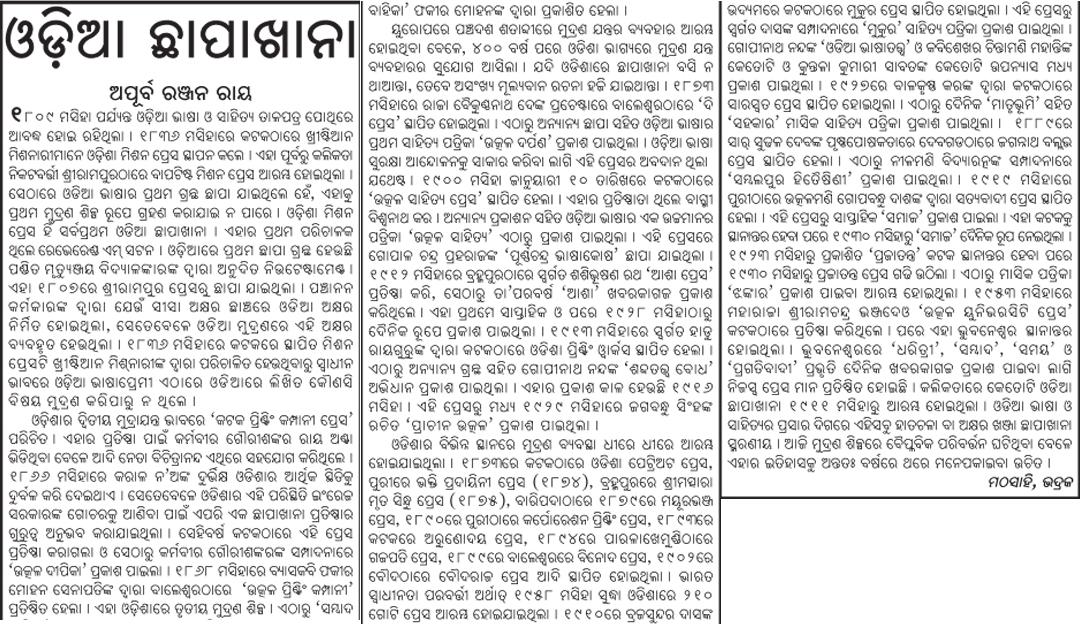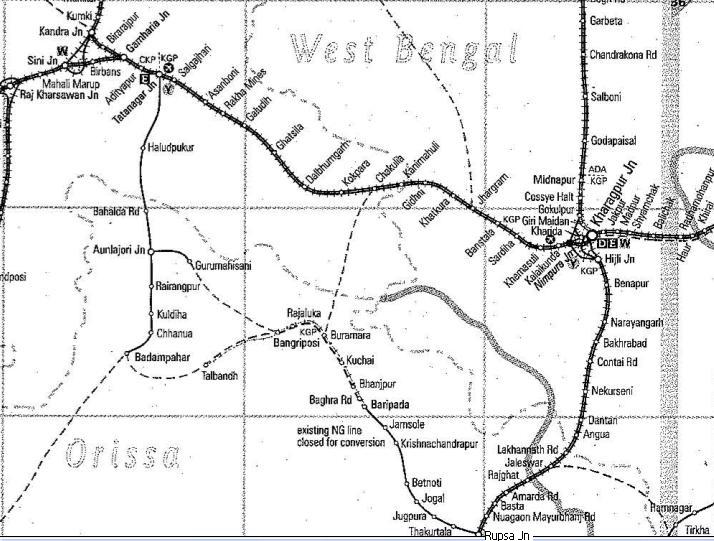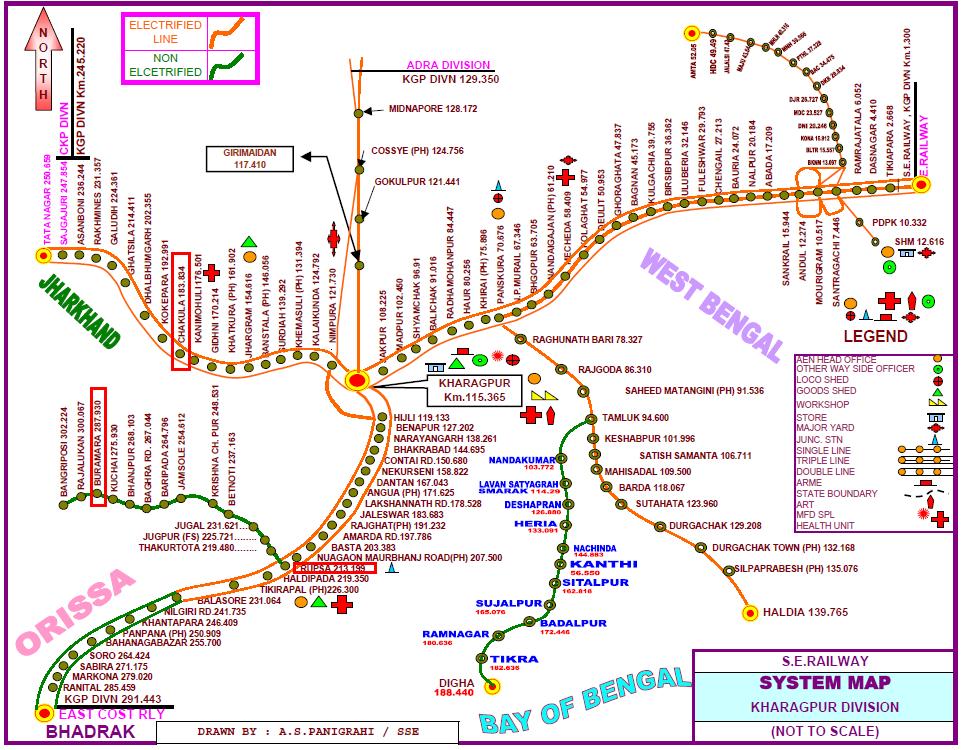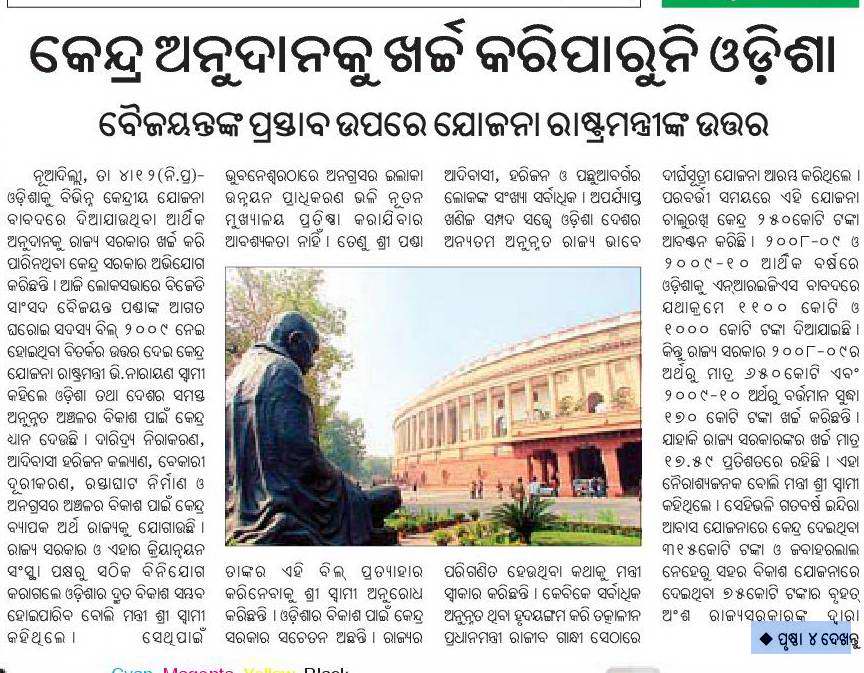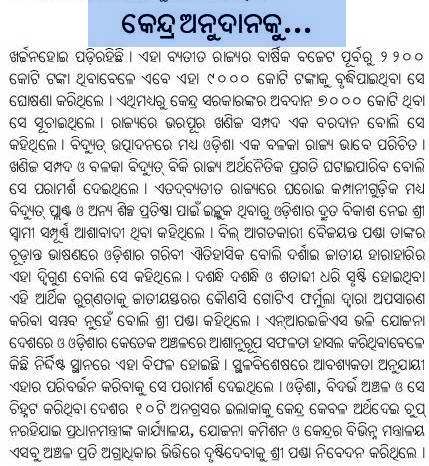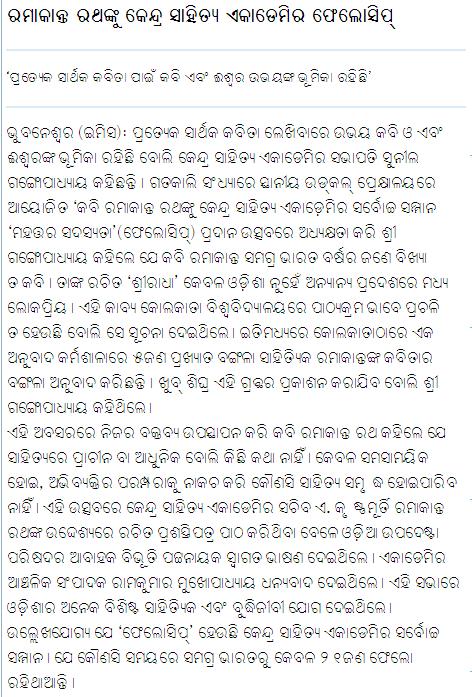Archive for December, 2009
Mural painting taken up on a high priority basis in Cuttack: Samaja
Bhubaneswar- Cuttack- Puri, Cuttack, Murals and Wall paintings Comments Off on Mural painting taken up on a high priority basis in Cuttack: SamajaOrissa MPs raise various issues in the parliament
Demanding equitable treatment, Kalahandi, Odisha issues in the Parliament, Odisha MPs, Railway network in Odisha, Railways Comments Off on Orissa MPs raise various issues in the parliamentThree mini-clusters proposed: Granite custer in Berhampur; Sponge Iron cluster in Bonai Rourkela; Handicraft cluster in Khurda
Balasore, Balasore- Chandipur, Berhampur- Gopalpur- Chhatrapur, Bhubaneswar- Cuttack- Puri, Central govt. schemes, Ganjam, Granite Cluster in Berhampur, Handicraft cluster in Khurda, Khordha, Rourkela- Kansbahal, Sponge Iron Cluster in Bonai, Sundergarh 1 Comment »(Thanks to Future Berhampur blog for the pointer.)
Following is an excerpt from a report in Business Standard.
The Centre has approved the development of four different sectors in Orissa including granite through the cluster approach under the Lean Manufacturing Competitiveness Scheme (LMCS).
These clusters include the Ganjam Granite cluster at Berhampur, the handicrafts cluster of the Khurda-based Trishakti Self Help Group (SHG), Sponge Iron cluster at Bonai near Rourkela and plastic cluster at Balasore.
New Delhi-based National Productivity Council (NPC) has been chosen as the nodal agency for the implementation of these cluster units. The formation of special purpose vehicles (SPVs) is necessary for the formal declaration of these cluster units.
“We have already taken steps to form the SPV for the granite cluster at Berhampur”, said Santosh Kumar Bebarta, secretary, Ganjam Granite Cluster. Once all the formalities are completed, the granite cluster will be launched, said B B Dhal, general manager, District Industry Centre (DIC), Ganjam. The deadline for the functioning of the proposed granite cluster is December 31 this year. The SPV of the particular cluster could get a funding up to Rs 10 crore from the Centre for setting up of the Common Service Centre (CSC).
The web page for the Lean Manufacturing Competitiveness Scheme (LMCS) is http://www.dcmsme.gov.in/schemes/lean-manufact.htm. In the pilot phase 100 mini-clusters have been proposed.
I hope the above pointers will be useful for readers to approach people and officials in their local area to pursue mini-clusters under the above scheme.
Roltas to prepare masterplan for Kalinganagar and 161 villages: Samaja
Jajpur, Jajpur Rd- Vyasanagar- Duburi- Kalinganagar, Kalinganagar corridors, Masterplans & CDPs Comments Off on Roltas to prepare masterplan for Kalinganagar and 161 villages: Samaja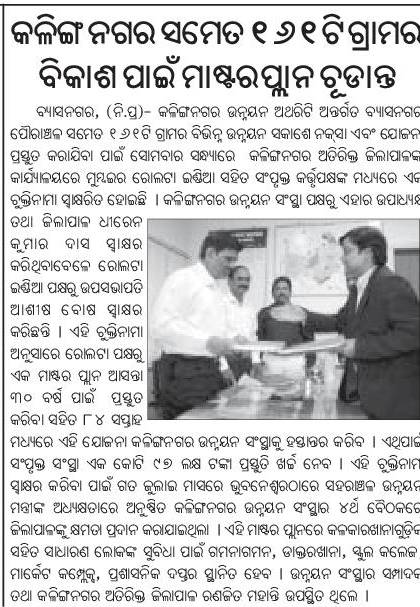
International standard tennis academy to come up in Bhubaneswar: Dharitri
Bhubaneswar- Cuttack- Puri, Cuttack, Khordha, Odisha sports 3 Comments »Current flight connectivity ranking of various urban agglomerations of India
Bhubaneswar, Bhubaneswar- Cuttack- Puri, Bringing International Connectivity 14 Comments »Following is extracted from http://pib.nic.in/release/release.asp?relid=55629. The ranking is based on "the average number of flights operated in a day from each of the International Airports in the country":
- Mumbai(MIAL) – 654, Juhu – 60
- Delhi – 666
- Chennai – 306
- Banglore (BIAL) – 280
- Kolkata – 231
- Hyderabad (GHIAL) – 219
- Cochin – 112
- Ahmedabad- 107
- Guwahati – 90
- Trivandrum – 71
- Jaipur – 66, Pune – 66
- Goa – 64
- Indore – 61
- Bhopal – 59
- Lucknow – 56
- Vadodra – 54
- Bhubaneswar – 50, Calicut – 50
- Nagpur – 48
- Coimbatore – 42
- Visakhapatnam – 33
- Ranchi – 32
- Raipur – 31
- Mangalore – 30
- Patna – 27, Srinagar – 27, Amritsar – 27
- Jammu- 23, Agartala – 23
- Trichy – 21, Chandigarh – 21, Udaipur -21
- Madurai – 20
- Imphal – 19, Bagdogra – 19
- Varanasi – 16
- Port Blair – 15
- Aurangabad – 14
- Silchar – 11
- Tirupati – 9
- Jodhpur – 7
- Leh – 6
- Rajkot – 6
- Gaya – 1
The mention of the word "international" in the above item is somewhat incorrect, as the list of international airports given in http://pib.nic.in/release/release.asp?relid=55628 is a different list. For example, Bhubaneswar is not in that list.
On related news, Bhubaneswar is among the 10 airports that are being taken up for city side development in the first phase. Following is an excerpt from http://pib.nic.in/release/release.asp?relid=55627.
In the 1st phase, ten airports namely Kolkata, Hyderabad (Begumpet), Vishakhapatnam, Bhubaneswar, Lucknow, Indore, Ahmedabad, Amritsar, Guwahati and Jaipur should be taken up for city side development.
Some of the facilities planned to be made available are hotels, restaurants, convention centres, food court, flight kitchen, petrol pump, retail shops, cargo facilities, parking etc.
The land available at the airports on the cityside is to be carried out and leased through open tender for development of facilities. The amount to be spent for city side development at each airport would depend upon the bid to be submitted by the successful bidder selected through competitive bidding.
An Idea: Besides new functional airports at Jharsuguda, Rourkela or both, and regional services in small planes to locations like Koraput, Joda-Barbil, Keonjhar, Baripada, Berhampur, Sambalpur, Jharsuguda, Rourkela, Lanjigarh-Bhawanipatna, Balasore, etc., one other way to develop the air connectivity of Orissa further is to develop air-bus terminals in cities and towns within two hours (200 kms) of Bhubaneswar. This would include luxury bus services and special counters at
- Cuttack station, Cuttack
- Puri
- Konark
- Dhenkanal, Angul, Talcher
- Chilika area (Barakul, Rambha), Chhatrapur, Berhampur
- Paradeep
- Kalinganagar
- Bhadrak, Balasore
- Bhubaneswar Station
- Khurda rd Station
The airport should bunch together its flights and have luxury buses (of various sizes) running 3-4 times a day to and from these destinations. Outside the airport there should be a luxury bus terminal for these flights. After getting off one should be able to take one of these buses (within an hour) to one of the above destinations right from the airport premises. Similarly, one should be able to take a bus from one of these locations to the Bhubaneswar airport.
This will be a win-win situation for every one. Since the population base that can use the airport will increase this will lead to more flights. Alternatively, various places will have somewhat of an air connectivity. (Note that in big cities it may take 1-2 hr to just to get to the airport.) It will also facilitate tourists.
Such bus servivce from airports to nearby cities is common in many parts of the world. I have used it in Mexico.
Kamat Hotels India Ltd (KHIL) redeveloping properties in Puri, Konark and Chilika
Bhubaneswar-Puri, Chilika, Circuit: Bhubaneswar-Chilika-Puri, Food joints, Hotels and resorts, Khordha, Konark, Puri, Puri, Sites in and around Bhubaneswar 1 Comment »Following is an excerpt from a report in hospitalitybizindia.com.
Kamat Hotels India Ltd (KHIL) which owns and operates hotels brands like The Orchid, VITS, Lotus Resorts and Gadh Hotels … has acquired the heritage palace ‘Mahodadhi Niwas’ in Puri and also the Eco Resort at Ramchandi, near the Sun Temple in Konark, in addition to the Parikud Palace and Rambha Palace, which are located near the Chilka Lake.
Of the three heritage properties acquired by KHIL, Mahodadhi Niwas opened for business on November 28, 2009. In the first phase, Mahodadhi offers 12 rooms and an additional 60 are expected to be developed over the next phase. KHIL is presently involved in restoring Parikud and Rambha Palaces, which will be commissioned in a phased manner in 2010.
… KHIL intends to strengthen the portfolio of its heritage brand – ‘Gadh Hotels’ in the state. We have already acquired three palaces from OTDC on a long-term lease and their restoration work is currently in progress.” As a part of its Corporate Social Responsibility (CSR) activity, KHIL has also undertaken cleaning and conservation task of Chilka Lake.
KHIL’s F&B arm Kamat Restaurants Pvt Ltd (KRPL), which operates the ‘Vithal Kamat’ chain of vegetarian quick-service restaurants is also making inroads in to Orissa. KRPL has recently commissioned four company-owned outlets in Orissa, on the Bhubaneswar-Puri highway.
Modern Terminal Market Coming up in Sambalpur; MP Amarnath Pradhan claims credit
Agricultural terminal, Central govt. schemes, Odisha govt. action, Odisha MPs, Sambalpur, Sambaplur- Burla- Bargarh- Chipilima Comments Off on Modern Terminal Market Coming up in Sambalpur; MP Amarnath Pradhan claims creditA short history of Oriya printing: op-ed from Dharitri
Odia language resources, Odia literature, Odisha history, Odisha Media Comments Off on A short history of Oriya printing: op-ed from DharitriUrban Infrastructure Development Scheme for Small and Medium Towns (UIDSSMT), a sub-component of JNNURM covers all towns and cities as per Census 2001 excepting 63 cities covered under JNNURM
NURM, JNNURM, UIDSSMT 5 Comments »(Thanks to Dilip for pointing to this scheme.)
Following is a one year old PIB on this.
Rajya Sabha
Urban Infrastructure Development Scheme for Small and Medium Towns (UIDSSMT) was launched on 3.12.2005 as a sub-component of the Jawaharlal Nehru National Urban Renewal Mission (JNNURM) covering all towns and cities as per Census 2001 excepting 63 cities covered under JNNURM. Water supply is one of the admissible component of UIDSSMT. State of Orissa has been provided Rs.181.79 crore for the Mission Period of 7 years (2005-12) under UIDSSMT. So far, 9 projects (7 projects on water supply, 1 on road and 1 on sanitation) in 6 towns namely Behrampur, Koraput, Paralakhemundi, Angul, Cuttack and Sambalpur have been sanctioned at an approved cost of Rs.112.52 croreinvolving total Central commitment of Rs. 91.70 crore under the scheme and Rs. 46.70 crore has been released to the State as 1st instalment of Additional Central Assistance (ACA) during 2006-07 and 2007-08. Details of the projects sanctioned so far to Orissa under UIDSSMT have been given in the Annexure.
This information was given by Shri Ajay Maken, MOS Urban Development in reply to a question by Shri B.J. Panda in Rajya Sabha today.
******
TFK/MT
The guidelines for this scheme is at http://www.cmao.nic.in/Resources/JNNURM/Guidelines/UIDSSMT-%20GUIDELINES.pdf.
I would request some of our readers to push for their contacts in Orissa to make sure (and if necessary offer help so that) their town takes advantage of this scheme. Hope our readers from Hinjlicut, Bhawanipatna, Balangir, etc. are listening.
RVNL seems to be taking up Buramara-Chakulia new line with upgradation of Rupsa-Buramara
Balasore, Baripada - Bangiriposi (under constr.), Buramara - Chakulia, Dhamara port (under constr.), Mayurbhanj, Rupsa Jn - Baripada, RVNL 3 Comments »The link http://www.rvnl.org/project/project_desc.php?id=74 has the following.
| NAME OF THE PROJECT– BURAMARA – CHAKULIA – NEW LINE WITH UPGRADING OF RUPSA – BURAMARA | |||
| Plan Head | NEW LINE | PIU | CPM KOLKATA |
| Rly. | SOUTH EASTERN | Executing Agency | RVNL |
| State | ORISSA | Funding Source | SPV |
| Length (Kms) | 125.00 | Status | Under Development Stage. |
| GQ/PC | PC | Anticipated Cost (Cr.) | 466.48 |
This is the latest addition to the list of RVNL projects. (15 of 60 projects in that list involve Orissa.) It is listed as a port connectivity (PC) project. Among the various proposed ports in that area, Dhamra port is closest to be operational. This link will shorten Rupsa-Chakulia distance from 167 kms to 125 kms. More importantly it will bypass the busy Kharagpur junction and provide an alternative path to Tatanagar. It will also provide a bypass of the area that sometimes gets flooded by the Subarnarekha river.
The following map illustrates the area. (Thanks to Samit for permitting to use this map fragment from his book.)
The following is from SER’s Kharagpur division map.
The complete list of 15 Orissa related projects listed at http://www.rvnl.org/project/project.php are:
- (11) KHARAGPUR (NIMPURA) – BHUBANESWAR (GQ electrification – completed)
- (12) BHUBANESWAR – KOTTAVALASA ELECT (GQ electrification – completed)
- (14) TALCHAR-CUTTACK-PARADEEP DOUBLING WITH 2ND BRIDGE ON RIVERS BIRUPA AND MAHANADI (GQ doubling completed)
- (15) DAITARI – BANSPANI NEW LINE (Port connectivity completed)
- (19) ANGUL – SUKINDA NEW LINE (Post connectivity – under development)
- (20) JAKHPURA- HARIDASPUR 3RD LINE DOUBLING (Port connectivity – recently sanctioned)
- (26) RAJATGARH – BARANG DOUBLING (GQ – work in progress)
- (27) CUTTACK – BARANG DOUBLING (GQ – work in progress)
- (28) KHURDA ROAD – BARANG 3RD LINE DOUBLING (GQ – work in progress)
- (44) HARIDASPUR – PARADEEP NEW LINE (Port connectivity – work in progress)
- (53) TOMKA -BANASPANI – RE (Port connectivity, electrification, recently sanctioned)
- (54) SAMBALPUR – TITLAGARH – DOUBLING (Port connectivity, recently sanctioned)
- (55) RAIPUR – TITLAGARH – DOUBLING (Port connectivity, recently sanctioned)
- (60) BANASPANI – JAKHPURA – DOUBLING (Port connectivity, electrification, unsanctioned)
- (63) BURAMARA – CHAKULIA – NEW LINE WITH UPGRADING OF RUPSA – BURAMARA (port connectivity, new line, under development)
With the Gopalpur port getting ready, RVNL should be soon taking up the Gunupur-Theruvali line.
Berhampur CDP to comprise of 317 sq. km. – to be ready in six months / Tender for Rourkela CDP
Berhampur- Gopalpur- Chhatrapur, Ganjam, Greater Berhampur, Greater Rourkela, Masterplans & CDPs, Rourkela- Kansbahal, Sundergarh 8 Comments »Following is an excerpt from a report in Hindu.
A Comprehensive Development Plan (CDP) for greater Berhampur is expected to be ready in next six months.
It was declared by Berhampur Development Authority Chairperson Sarat Ranjan Patnaik at a workshop organised in the city on Saturday to elicit views from corporators and councillors of the local urban bodies under the BDA.
The technical team that attended the workshop was led by chief planner of the Town and Country Planning Organisation (TCPO), J.B. Khirsagar. The TCPO, which happens to be the technical advisory body of Central Ministry of Urban Development, is preparing the CDP for greater Berhampur.
Mr. Patnaik said earlier the TCPO decided to prepare the master plan in 18 months. But due to requests of the BDA, the TCPO authorities have agreed to expedite the process and complete the process in one year.
He expected the master plan to be ready in another six months.
… The Orissa government is bearing the cost of the CDP preparation, which would cost around Rs. 1.08 crores. Mr. Khirsagar said the TCPO was providing the technical collaboration without taking any consultancy fee.
… The present CDP is being prepared keeping in view the development of greater Berhampur till the year
19312031.The area under greater Berhampur will include the urban centres of Berhampur, Gopalpur and Chatrapur and 139 villages between them.
The CDP will comprise a total area of 317 sq. km. having a population of around 12 lakhs.
Similar CDPs for other areas need to be prepared at the earliest.
A search in the web leads to the call for tenders for CDP for Berhampur area as well as Rourkela area. Some numbers from that document is as follows:
Abstract of area and population on Berhampur Development authority
| Area category | Area in Sq kms | 2001 population | 2009 population estimate using gazetteer |
| Urban Berhampur, Chhatrapur and Gopalpur | 149.62 | 4,11,007 | Add 402,672- 307,792 = 94,880 |
| Rural hamlets (Intervening Villages) | 168 | 1,02,753 | Add 8,000 |
| Total | 317.62 | 5,13,760 | 6,16,640 |
Abstract of area and population on Rourkela Development authority
| Area category | Area in Sq kms | 2001 population | 2009 population estimate using gazetteer |
| Urban | 75.69 | 4,72,335 | Add 550,668 – 484,292= 66,376 |
| Rural | 183.49 | 59,070 | Add 5,000 (rural areas grow slower) |
| Total | 259.18 | 5,31,405 | 6,02,781 |
Orissa RTI website is http://rtiorissa.gov.in/
E-governance, Odisha govt. action, Odisha RTI, Websites of Interest Comments Off on Orissa RTI website is http://rtiorissa.gov.in/The official site http://rtiorissa.gov.in/ has tons of information.
Kudos to MP Srikant Jena for getting 51 crores for the Balasore plastic cluster
Balasore, Odisha MPs, Plastic products cluster - Balasore Comments Off on Kudos to MP Srikant Jena for getting 51 crores for the Balasore plastic cluster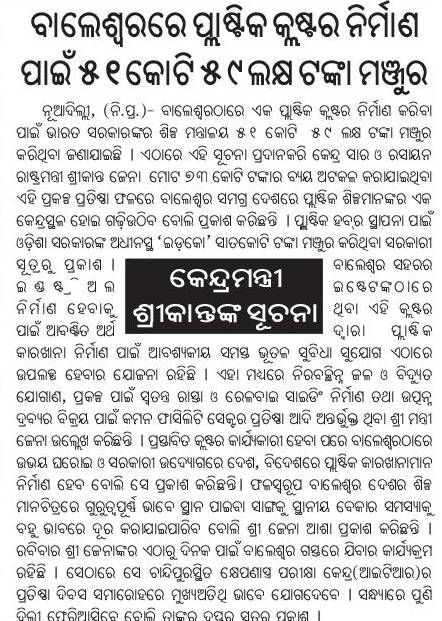
Kudos to MP Bhakta Das for getting 188 crores allocated for Kalahandi and Nuapada highways: Samaja
Kalahandi, NH 201 (310 Kms: Boriguma - Bhawanipatna - Balangir - Bargarh), NH 217 (438 Kms: Chhattisgarh Border - Khariar Rd - Nuapada - Khariar - Titlagarh - Ramapur - Baligurha - Asika - Brahmapur - Gopalpur), Nuapada, Odisha MPs, State highways 2 Comments »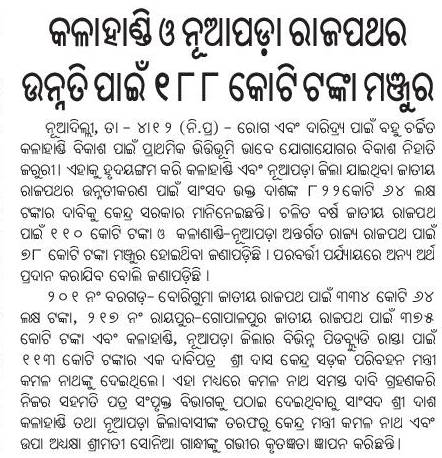
Orissa needs to better spent its NREGS and Indira Awas allocation
Central govt. schemes, Central grants, Central programs, IAY, NREGS, Odisha issues in the Parliament, Odisha MPs, Planning Commission and Odisha, Samaja (in Odia) Comments Off on Orissa needs to better spent its NREGS and Indira Awas allocationSahitya Academy fellows from Orissa: Poet Ramakanta Rath is the latest
Odia literature, Odisha personalities 3 Comments »So far there have been five Sahitya Academy fellows from Orissa. The latest is Ramakanta Rath, who received the fellowship this year. The list of five (extracted from wikipedia) are:
- 1971: Kalindi Charan Panigrahi (1901–1991), Oriya poet, novelist, story writer, dramatist and essayist
- 1994: Kanhu Charan Mohanty (1906–1994), Oriya novelist
- 1996: Sachidananda Raut-Roy (1916–2004), Oriya short story writer and poet
- 2006: Manoj Das (1934), Oriya writer
- 2009: Ramakanta Rath (1934), Poet
At anytime there are at most 21 fellows. So currently there are two from Orissa.
Following is a report from Sambada on Ramakanta Rath receiving the fellowship.
There are three Jnanpith award winners from Orissa. They are:
- 1973 : Gopinath Mohanty for Paraja
- 1986 : Sachidananda Rout Roy
- 1993 : Sitakant Mahapatra
Orissa should pursue health institutes in rural areas through NRHM
CENTER & ODISHA, HEALTHCARE and HOSPITALS, NRHM 1 Comment »Following is from PIB http://pib.nic.in/release/release.asp?relid=55153. Orissa should learn from this and pursue health insitutes for its rural areas.
Under National Rural Health Mission[NRHM] an amount of Rs. 108.53 crores was sanctioned for the RCH Centre for Excellence, Tamil Nadu with the following components :1. Institute of Obstetric and Gynecology, Egmore
2. Institute of Government Kasthurba Gandhi Hospital, Triplicane
3. Training Centre for Health & FW Institute, Egmore
4. Training for Multipurpose Health Supervisor[F] Training Institute, Triplicane
The services for patients include out patient services, special clinics, diagnostic service, in patient care along with comprehensive emergency Obstetric & Neonatal care services and training for medical staff with renewed infrastructure and facilities.
This information was given by Shri Ghulam Nabi Azad, Union Minister for Health & Family Welfare in a written reply to a question in the Lok Sabha today.
DS/GK
Indrani Patnaik Mines and Triveni Earth Movers charged by Orissa government for illegal mining
Alleged rogues, Iron Ore 3 Comments »Following is an excerpt from an IANS report by Hardeep Sidhu in topnews.in.
The Orissa vigilance department Thursday filed criminal cases against the state’s two leading companies for their alleged involvement in illegal mining, a senior official said.
"The cases have been filed against Indrani Patnaik Mines and Triveni Earth Movers at vigilance police station at Balasore," Vigilance Department Director Anup Kumar Patnaik told IANS.
He said that 10 cases of illegal mining have been filed till now. Balasore is some 200 km from here.
Both companies have been accused of illegally mining iron ore in the mineral rich district of Keonjhar. …
Some good Orissa related web sites and blogs; please suggest others
Websites of Interest 1 Comment »Following are some good Orissa related web sites and blogs created by individuals (not companies or government). Besides some of the news sites (Tathya.in, Dharitri, Samaja, Sambada, etc.) I check the following ones quite often.
- Regional blog: Berhampur
- Travel Tales in Orissa
- Odia Music
- Blog with many postings on Orissa Jungles
- Regional Blog: Western Orissa
- Regional blog: Kalahandi
I hope more people take such activities as their hobbies. In particular, regional blogs on Rourkela, North Orissa (Balasore, Baripada), Central Orissa (Angul), and Koraput region would be very helpful for all round devlopment of Orissa. Any volunteers? One does not have to do it alone. A group of people can join hands and do it.
Bargarh and Sonepur among the 20 pilot Handloom Clusters of India
Bargarh, Bargarh, Cottage industry and Handlooms, Handloom Clusters, MSE - medium and small enterprises, Rural artisan villages, Sambalpuri Sarees, Sambaplur- Burla- Bargarh- Chipilima, Sonepur, Sonepur Comments Off on Bargarh and Sonepur among the 20 pilot Handloom Clusters of India(Thanks to http://kddf.wordpress.com/2009/12/02/information-about-subarnapur-district-handloom-cluster/ for the inspiration to write about this.)
The following is from the pages http://www.indianhandloomscluster-dchl.net/index.asp.
The overall handloom situation in Orissa is as per the following table:
|
DISTRICT WISE CLASSIFICATION OF HANDLOOMS AS PER CENSUS 1995-96 |
||||||
|
No. of Looms |
Up to 1000 |
1000-5000 |
5,000 – 10,000 |
10,000-25,000 |
25,000 – 50,000 |
Above 50,000 |
|
|
1 |
2 |
3 |
4 |
5 |
6 |
|
STATE : ORISSA |
||||||
|
|
Deogarh |
Angul |
Bolangir |
Bargarh |
|
|
|
|
Gajapati |
Bhadrak |
Cuttack |
|
|
|
|
|
Jharsuguda |
Dhenkanal |
Ganjam |
|
|
|
|
|
Keraput |
Kendrapara |
Nayagarh |
|
|
|
|
|
Malkanagiri |
Keenjhar |
Sonepur |
|
|
|
|
|
Nawarangapur |
Nuapara |
|
|
|
|
|
|
Phulbani |
Puri |
|
|
|
|
|
|
Rayagada |
Sambalpur |
|
|
|
|
|
|
Sundargarh |
Kalahandi |
|
|
|
|
|
|
|
Balasera |
|
|
|
|
|
|
|
Boudh |
|
|
|
|
|
|
|
Jagatsinghpur |
|
|
|
|
|
|
|
Jajpur |
|
|
|
|
|
|
|
Mayurbhanj |
|
|
|
|
|
|
|
Khurda |
|
|
|
|
|
|
9 |
15 |
5 |
1 |
30
|
|
Among those, Bargarh and Sonepur are among the 20 pilot clusters.
The page for the Baragarh cluster is http://www.indianhandloomscluster-dchl.net/Bargarh/Index.asp. Following is some information from that page.
Bargarh Handloom cluster is spread over the entire Block of Bargarh, Attabira, Bijepur and Sohella. The cluster has 7158 numbers of looms as per the survey report of the zonal Handloom office taken up during the year 2004 out of which 5102 looms are working in 299 different villages. The main products of the cluster are cotton sarees of tie and dye and small amount of dress materials, lungis and napkins etc. The annual production is around 10 Crores rupees. The products of this area are mostly marketed in Orissa and National market. The cluster so to say represents Orissa in quantitative and qualitative Tie and Dye Cotton Sarees as no other clusters of other districts in Orissa produces such sarees.
… The weaving in the cluster by the traditional weavers’ community popularly known as "Bhulia" came in to existence during mid of 17th century and with increase in their population, they spread to other nearby places. They initially belong to Rajasthan and were presented during the 14th century to the ruler of Patna State, a king of Chouhan dynasty "Ramai Deb". Later on they were presented to the king of Sonepur during the 16th century and scattered to the nearby district i.e., Bargarh in the next century.
The cluster consists sizable number of professional weavers (Non traditional) from Schedule Caste and Schedule Tribe (Kuli caste) weavers, which in total accounts for 60 %. Generally these weavers are less skilled and engaged in production of Napkin, Lungi, Sarees, Dhotis, etc.
Weaving with Tie dye in the cluster prior to 40”s was done with 40”/42” looms operated with hanging slay and engaged in producing Kapta, Lungi and Napkins made of 12’s/16’s/20’s cotton yarn. The yarns were dyed with vegetable colours. The main colours were Yellow (from Turmeric), Maroon (From bark of Aal tree), Blue form Nile and Black (From Hirakasi and Chakda Seeds). Fabrics of vegetable colours were sometimes not fast and ranges of colours were also limited, forcing the Tie-Dye production in to limited colours and so also the design. Such practice was on vogue till the mid of 40s when vat colour was first substituted for in place of some vegetable colours.
The next major changes in the cluster took place with the introduction of twisted cotton mercerized yarn and synthetic colours in the early 60’s. The looms started widening mainly to 52" width for normal sarees and other production and 90" for double bed sheet production. There were also few 60” / 72" looms to accommodate weaving of middle-sized bed sheets.
Activities in the cluster started taking momentum with the involvement of Late Padmashree Dr. Krutartha Acharya and his four associates in the cluster area during 1942 and started their business with production on limited numbers of looms. Later he converted his business in to a co operative society named Sambalpuri Bastralaya, registered during the year 1954 under "Bihar and Orissa Co operative Societies Act" and established in Bargarh town. This is the first firm in the cluster, which took the leadership in weaving activities of cluster and stood as a milestone in its history.
… Unlike the Tie-Dye work of other states of India, the motif and designs of the cluster are infinite in number and every motif or design is categorized under a special caption. No design is let out without giving it a name. It shows the creative mind of the weavers of the region.
The page for the Sonepur cluster is http://www.indianhandloomscluster-dchl.net/Sonepur/Index.asp. Following is some information from that page.
The writing in the stones of Kahandagiri cave Orissa suggests that the art of weaving was in Orissa before 600 B.C. Similarly some carving in the temples of Sonepur cluster (Baidyanath) indicates that weaving was in existence in the area during prior to 9th B.C. Besides weaving with cotton yarn, there was also weaving with wild silk (Tassar), wool and fibers from stem of lotus. The tie-dye weaving in western Orissa came in to existence during mid of 14th century when 100 weaver’s families were brought from Raipur area of Madhya Pradesh by the then ruler of Patnagarh Sri Ramai Dev. The weavers’ later on titled as Meher and their caste known as Bhulia. Such weavers were traditionally weaving the tie and dye fabrics. Orissa has also history of exporting handloom to south-east Asia countries like Thailand, Java, Borrneo and Sumatra (Last three are Island of Indonesia) during pre-independence period in sea route. It is therefore also the bank of river Mahanadi and some other big river of Orissa has developed weaving culture.
The Bomkai Designs are the traditional designs in production in the village named Bomkai in Ganjam District of Orissa. Latter on it is introduced in Sonepur. Before 1950’s the main product mix of this cluster was cotton sari and Dhotis. The main occupation of "Bhulia" community was weavings. Weavers had looms of short width and they used to weave cotton sari of length 12ft and its width was 36 inches. During that period, cotton yarn of (10 to 40) counts were available in the market.
Weavers by own used to sell woven sari at nearby locally market and whatever they got remuneration by selling the sari, they used to brought yarn for further weaving. During this period, due to absence of chemical dyes, mainly vegetable dye was used to dye the yarn. Vegetable dye had limited colours i,e yellow (From Turmeric), Maroon (From bark of Aal trees), Blue (Nile) and black (Hirakasi and Chakda seeds). The colour of vegetable dyes was not fast in the fabrics. The vegetable dye has limited ranges of colour that limit the design of tie & dye fabrics. During mid of 1950’s the late Padamshree Sri Kruthartha Acharya was the up-coming entrepreneur in handloom sector. He was belonging to Bargarh sub-division which was neighbouring district of Sonepur. He had installed 200 looms at Sonepur and established a unit for producing handloom sarees. During mid of 1960’s, lots of modifications were done to upgrade the handloom sector of Sonepur. The widths of looms were widening up to (48 to 50) inches; mercerized yarns of finer quality (60 counts) were introduced. Shri Kruthartha Acharya also introduced chemical dyes. Many weavers were trained to adopt the change. Due to introduction of chemical dye, the ranges of colour shed were increased which helps the weavers to produce variety of design in tie and dye fabrics. Slowly other weavers of the cluster adopted the new technology. Dr Acharya also searched other market by promoting the Sonepur product in other States by participating in exhibition and fair conducted by handloom department, Govt. of India. He also used to purchase the woven sari from weaver and used to supply raw materials and design to them. This helped the weavers to only concentrate on production work instead of marketing the products. Latter on during 1954, Dr. Achaya converted his firm into cooperative society named Sambalpuri Bastrayala Handloom Cooperative Society Ltd, Bargarh, which is at present stand as a leading PWCS of not only the State but also of the country. During mid Seventies G.O.O. initiated a corporation called Orissa Handloom Development Corporation which grew and decayed in two decades and has been liquidated recently. The other major changes taken place in the cluster was introduction of silk yarn in early 1980’s. The body part of silk fabric was woven with silk yarn and Anchal by cotton tie and dye. It took two – three years to develop Jala design which helped the weaver to design the fabric in simple way. This Bomkai design were developed in the late 80’s and introduced in early 1990’s in the cluster. Since then, the permutation and combination of designs involving in tie-dye, Bomkai, Jala etc are practicing in the cluster. Latter on Body design was also developed to make the fabric more attractive and Zari were used to add value to the fabric. Weaver co-operative societies were the major firms operating in the handloom sectors. These societies were large in number during mid of 90’s. The entry of private entrepreneurs and private traders started from 1980’s. Padamshri Chaturbhuj Meher had entered in this sector in early 1980’s and had great contribution in this sector. On the other hand gradual reduce in the Government subsidies, declining support from apex WCS, closure of Handloom Development corporation and mismanagement at the primary wcs level are the main reasons of reduction in the number of active co-operative societies. Unlike the Tie-Dye work in the other part of India, the motif and design of the cluster are infinite in number and every motif or design is characterized under a special caption. No design is let out without giving it a name. It shows the creative mind of the weavers of region. Orissa had 129236 (1951), 119005 (1987) and 92869 (1996) as per the handloom figure census, which shows the continuous decline in the loom position. The total looms in Sonepur district is 7243 (As per the survey conducted by ADT office Sonepur). The product mixes are cotton sari, silk sari and dress material. The total production of the cluster in the Co-Operative Sector is Rs 985.46 lacs.
